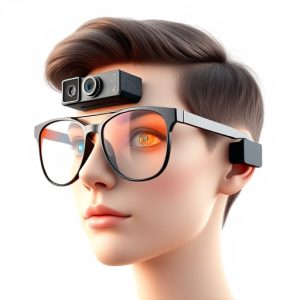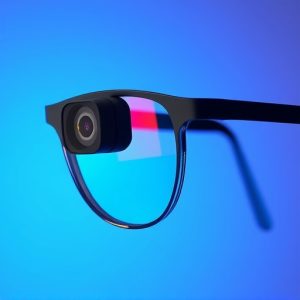Camera-Enabled Glasses: Merging Functionality, Design, and Privacy Concerns
Glasses equipped with cameras and audio recording capabilities are revolutionizing personal documen…….
Glasses equipped with cameras and audio recording capabilities are revolutionizing personal documentation by enabling users to capture high-quality images and sound with ease. These sophisticated devices not only enhance everyday experiences with first-person perspectives but also are pioneering advancements in augmented reality, surveillance, medical imaging, real-time language translation, and more. As they evolve, we can expect improvements in image stabilization, low-light functionality, connectivity, and audio clarity, making them increasingly valuable across various sectors. The integration of smart assistant interaction, voice recording, and video conferencing expands their utility in education and journalism, signaling a leap forward in wearable technology that creates a more interconnected digital environment. Designed with user comfort in mind, these intelligent glasses offer a stylish and functional solution for capturing life's moments, with features like adaptive lighting, discreet placement of cameras and microphones, and privacy-centric software updates. However, the widespread adoption of these devices raises important privacy and security concerns that must be addressed through strong data encryption, secure storage solutions, and clear user policies to protect sensitive information and prevent misuse. Both manufacturers and users have a responsibility to navigate the ethical landscape of this technology responsibly, ensuring that it enriches experiences without compromising individual privacy and security.
21st-century eyewear transcends mere vision correction, with glasses with a camera built in revolutionizing personal interaction and content capture. This article delves into the multifaceted world of these innovative devices, examining their capabilities, the seamless integration of audio functionality to enrich user experience, design advancements ensuring comfort and style, and the critical privacy, security, and ethical debates they prompt. Join us as we explore the transformative potential of glasses with a camera built in, a technology that is reshaping our daily lives and interactions with the world around us.
Exploring the Capabilities of Glasses with a Built-in Camera: A New Era of Visual Technology
The integration of cameras into glasses has ushered in a new era of visual technology, offering users an unprecedented level of interaction with their environment. Glasses with a camera built-in are becoming increasingly sophisticated, capable of capturing high-resolution images and video with the convenience of a hands-free experience. These devices are transforming how individuals record life’s moments, providing a first-person perspective that was previously unattainable. The potential applications for this technology are vast, ranging from enhanced reality experiences to professional uses in fields like surveillance, medical imaging, and even real-time language translation. As the technology matures, we can expect advancements in image stabilization, low-light performance, and seamless connectivity to other devices, further solidifying these glasses as a staple in personal and professional settings alike.
Moreover, the integration of audio capabilities complements the visual prowess of glasses with a camera built-in. The addition of microphones allows for hands-free voice recording and the ability to interact with smart assistants or conduct video calls without the need for additional equipment. This dual functionality not only enhances the user experience but also opens up new possibilities in education, where students can record lectures, in journalism, for immersive storytelling, and in various other sectors that rely on both visual and auditory data capture. The fusion of these capabilities within a wearable device signals a significant shift towards a more interconnected and responsive digital world.
The Integration of Audio Functionality into Camera Glasses: Enhancing User Experience
Glasses equipped with cameras have become increasingly sophisticated, offering users the ability to capture moments with ease and convenience. The integration of audio functionality into these camera glasses takes this innovation a step further, enhancing the user experience by allowing for more comprehensive recording capabilities. This dual-functionality means that users can now record both high-quality visuals and crystal-clear audio, providing a multidimensional documentation of events. The implications for users ranging from professionals like journalists or vloggers to everyday individuals looking to capture life’s precious moments are significant. These devices enable seamless content creation, where the context of sound enriches the narrative that the visuals alone might not convey.
Furthermore, the audio component in camera glasses is designed with user-friendliness in mind. Advanced microphone arrays ensure that the audio captured is as clear and free from background noise as possible. This technology filters out unnecessary sounds, focusing on the intended auditory elements. The result is a high-fidelity audio experience that complements the visual footage, making for more immersive and engaging content. Additionally, the integration of this feature does not compromise the sleek design or comfort of the glasses, maintaining an unobtrusive presence while in use. As these glasses with a camera built in continue to evolve, they are poised to become indispensable tools for anyone looking to document their world through both sight and sound.
Innovations in Design: Comfort and Style in Camera-Equipped Glasses
The integration of cameras into eyewear has revolutionized the way individuals interact with their surroundings, capturing moments and facilitating augmented reality experiences seamlessly. Today’s glasses with a camera built in are not just technological marvels; they are also paragons of design innovation that prioritize comfort and style. These devices are crafted with ergonomic considerations to ensure they sit lightly on the face, providing an unobtrusive presence throughout the day. The frames are available in a variety of sleek designs, catering to different tastes and styles, from classic to contemporary. Advanced materials are employed to enhance durability while maintaining lightweight properties. The lenses, where the camera components reside, are designed with precision optics to not interfere with vision clarity, ensuring users can enjoy their field of view unencumbered by the presence of the technology.
Furthermore, the user experience is central to the design process. Glasses with a camera built in are equipped with user-friendly interfaces that allow for effortless operation of the camera functions. The placement of the cameras and microphones is strategically optimized to capture high-quality audio and video without drawing unwanted attention or disrupting the wearer’s natural line of sight. Additionally, these glasses often feature adjustable settings for different lighting conditions, ensuring that the captured images and videos are true to life. The focus on user comfort extends beyond physical design; it also encompasses the software experience, which is regularly updated to improve functionality and enhance privacy features, keeping users’ needs and concerns at the forefront of innovation in this space.
Privacy, Security, and Ethical Considerations in the Use of Glasses with Cameras
The advent of glasses equipped with cameras and audio recording capabilities has ushered in a new era of personal computing and augmented reality experiences. As these devices become more prevalent, they raise significant concerns regarding privacy and data security. Users must be vigilant about the environments in which they operate these devices, as inadvertent recordings could capture sensitive information, potentially compromising individual privacy. Manufacturers are tasked with implementing robust encryption methods and secure data storage solutions to protect recorded data from unauthorized access. The ethical implications of such technologies also demand careful consideration. Issues surrounding consent, surveillance, and the potential for misuse by bad actors must be addressed through clear policies and user education. Users should have complete control over their data, including options to opt-in or out of certain features, and transparency regarding how and where their information is processed and stored. The responsibility falls on both the creators of these glasses and the users themselves to navigate this complex landscape responsibly, ensuring that the technology enhances experiences without infringing on the rights of individuals or compromising their security.


